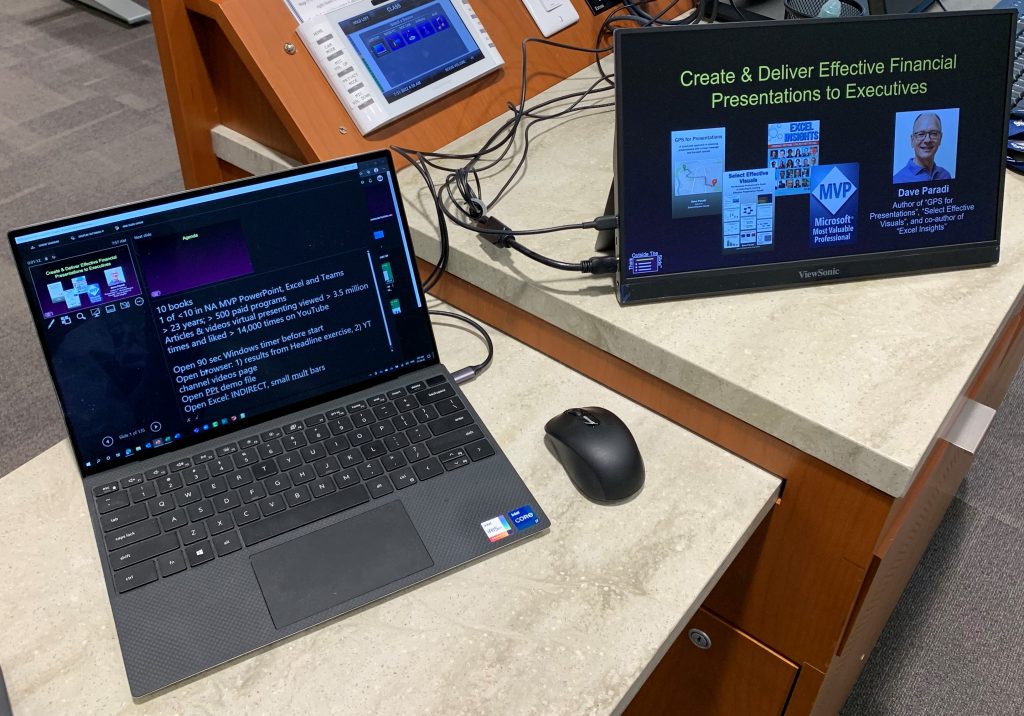This article shares one of the lessons I learned when planning and running a hybrid class reunion event in May 2022. Read the introduction and see the other lessons in this series here.
Lesson
In the event I was running each laptop only had its own screen, I didn’t have any extra monitors connected to a laptop. The problem came when I wanted to control some aspect of the meeting while content was being shown from that laptop. As soon as you use the meeting controls it can change what is shown on the big screens in the room and online. This can also change how a running app works or is controlled. I had considered bringing a second screen but it was too much to transport and too large because at the time I only had regular monitors. Having a second screen would have helped a lot. That’s one of the reasons my current hybrid meeting setup now includes a portable second monitor (you can read more about my current setup including the equipment I now use).
Applying this lesson to your meetings
Have one screen for content, one for meeting control
I recommend having a second screen connected to your laptop for important hybrid meetings or events. This allows you to separate the content and the control. I use my portable second screen for the content that is shared in the room and in the virtual meeting. The only apps that go on that screen are ones I want the audience in the room and online to see.
The laptop screen is for meeting control. That is where I can spotlight someone’s video, chat with the online participants, and control any meeting functions. Because this screen is not ever shared in the room or online, the audience doesn’t get distracted with what I am doing in the meeting platform. The shared screen continues to display what I want without people even knowing I am doing something else.
Here’s what my setup looks like with the laptop screen on the left being the control screen and the portable monitor on the right being the content screen.

Consider a second device for meeting control
Instead of a second screen, you could consider using a second laptop to control the meeting platform. Connect this second laptop as a participant in the virtual meeting and give it co-host privileges so it can control the meeting. The challenge with this approach is that you have to switch between laptops during the meeting when you want to switch from controlling the content to controlling the meeting. This requires more concentration and awareness. I did have a second laptop for the audio and video in the room at the event and it was confusing to switch between the laptops even though I was trying to concentrate. Switching laptops can introduce a level of complexity that you may not want to take on.
Plan and practice your setup
Whichever setup you choose, plan out how you will move through each aspect of the meeting. Create a script or at least a sequence of notes that you can follow so you don’t have to remember every step. Think about how you will switch between the different content you will share, when you will have just the videos on the screen, and whether you want to spotlight a video at a certain time. Don’t think you can just figure it out on the fly, it won’t work well. In a previous lesson I expanded on the importance of practicing with your hybrid setup.
Wrapup
Hybrid meetings introduce the complexity of being responsible for the content and the meeting control. This requires more thought and it is made easier with additional equipment to separate those two roles. Consider your options and select a setup that will work for you.

Dave Paradi has over twenty-two years of experience delivering customized training workshops to help business professionals improve their presentations. He has written ten books and over 600 articles on the topic of effective presentations and his ideas have appeared in publications around the world. His focus is on helping corporate professionals visually communicate the messages in their data so they don’t overwhelm and confuse executives. Dave is one of fewer than ten people in North America recognized by Microsoft with the Most Valuable Professional Award for his contributions to the Excel, PowerPoint, and Teams communities. His articles and videos on virtual presenting have been viewed over 4.8 million times and liked over 17,000 times on YouTube.
